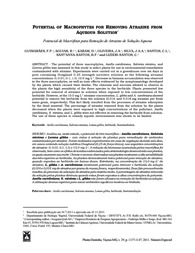Potential of macrophytes for removing atrazine from aqueous solution.
Potential of macrophytes for removing atrazine from aqueous solution.
Author(s): GUIMARÃES, F. P.; AGUIAR, R.; KARAM, D.; OLIVEIRA, J. A.; SILVA, J. A. A.; SANTOS, C. L.; SANTANNA-SANTOS, B. F.; LIZIERI-SANTOS, C.
Summary: The potential of three macrophytes, Azolla caroliniana, Salvinia minima, and Lemna gibba was assessed in this study to select plants for use in environmental remediation contaminated with atrazine. Experiments were carried out in a greenhouse over six days in pots containing Hoagland 0.25 strength nutritive solution at the following atrazineconcentrations: 0; 0.01; 0.1; 1.0; 10.0 mg L -1. Decrease in biomass accumulation was observed in the three macrophytes, as well as toxic effects evidenced by the symptomatology developed by the plants which caused their deaths. The chlorosis and necrosis allowed to observe in the plants the high sensitivity of the three species to the herbicide. Plants presented low potential for removal of atrazine in solution when exposed to low concentrations of the herbicide. However, at the 10.0 mg L-1 atrazine concentration, L. gibba and A. caroliniana showed potential to remove the herbicide from the solution (0.016 and 0.018 mg atrazine per fresh mass gram, respectively). This fact likely resulted from the processes of atrazine adsorption by the dead material. The percentage of atrazine removed from the solution by the plants decreased when the plants were exposed to high concentrations of the pollutant. Azolla caroliniana, S. minima, and L. gibba were not effective in removing the herbicide from solution. The use of these species to remedy aquatic environments was shown to be limited
Publication year: 2011
Types of publication: Journal article
Unit: Embrapa Maize & Sorghum
Keywords: Azolla caroliniana, Biorremediação, Herbicida, Herbicides, Lemna gibba, Salvinia minima
Observation
Some of Embrapa's publications are published as ePub files. To read them, use or download one of the following free software options to your computer or mobile device. Android: Google Play Books; IOS: iBooks; Windows and Linux: Calibre.
Access other publications
Access the Agricultural Research Database (BDPA) to consult Embrapa's full library collection and records.
Visit Embrapa Bookstore to purchase books and other publications sold by Embrapa.

